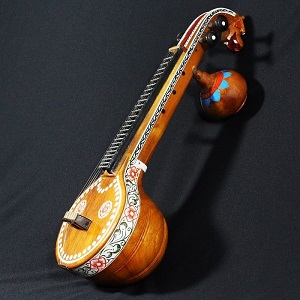Saraswati Veena
 The veena is a large plucked lute and one of India’s oldest instruments with a recorded history going back to about 1500 BC. While it is getting rarer in North India, the veena remains a predominant solo instrument in the Carnatic music tradition, in South India, where it is known specifically as Saraswati veena, named after the goddess of art, music, and learning, who is usually depicted holding or playing the instrument.
The veena is a large plucked lute and one of India’s oldest instruments with a recorded history going back to about 1500 BC. While it is getting rarer in North India, the veena remains a predominant solo instrument in the Carnatic music tradition, in South India, where it is known specifically as Saraswati veena, named after the goddess of art, music, and learning, who is usually depicted holding or playing the instrument.
The veena is among the oldest of Indian musical instruments. From the references to Vedic writings, it can date back to around the first millennium B.C. Temple sculptures from the 2nd century B.C. show a type of veena being played.
The Saraswati veena is the predominant Carnatic music and the Rudra veena the most played veena in Hindustani music. The Saraswati veena has seven strings strung over twenty four fixed frets. It has a large resonator (kudam), a tapering hollow neck (dandi) and a tuning box that curves downwards (yali).
The veena is said to be the only instrument that can play all the gamakas (oscillations) in Carnatic music, usually something that only the most proficient vocalists can achieve.
The Hindu Goddess of Knowledge, Saraswathi, is said to play the Veena. Pictures depict her sitting on a lotus and playing the instrument.